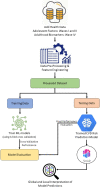Explainable machine learning framework for predicting long-term cardiovascular disease risk among adolescents
- PMID: 36536006
- PMCID: PMC9763353
- DOI: 10.1038/s41598-022-25933-5
Explainable machine learning framework for predicting long-term cardiovascular disease risk among adolescents
Abstract
Although cardiovascular disease (CVD) is the leading cause of death worldwide, over 80% of it is preventable through early intervention and lifestyle changes. Most cases of CVD are detected in adulthood, but the risk factors leading to CVD begin at a younger age. This research is the first to develop an explainable machine learning (ML)-based framework for long-term CVD risk prediction (low vs. high) among adolescents. This study uses longitudinal data from a nationally representative sample of individuals who participated in the Add Health study. A total of 14,083 participants who completed relevant survey questionnaires and health tests from adolescence to young adulthood were chosen. Four ML classifiers [decision tree (DT), random forest (RF), extreme gradient boosting (XGBoost), and deep neural networks (DNN)] and 36 adolescent predictors are used to predict adulthood CVD risk. While all ML models demonstrated good prediction capability, XGBoost achieved the best performance (AUC-ROC: 84.5% and AUC-PR: 96.9% on testing data). Besides, critical predictors of long-term CVD risk and its impact on risk prediction are obtained using an explainable technique for interpreting ML predictions. The results suggest that ML can be employed to detect adulthood CVD very early in life, and such an approach may facilitate primordial prevention and personalized intervention.
© 2022. The Author(s).
Conflict of interest statement
The authors declare no competing interests.
Figures








Similar articles
-
A Risk Prediction Model for Physical Restraints Among Older Chinese Adults in Long-term Care Facilities: Machine Learning Study.J Med Internet Res. 2023 Apr 6;25:e43815. doi: 10.2196/43815. J Med Internet Res. 2023. PMID: 37023416 Free PMC article.
-
Sex-specific cardiovascular disease risk prediction using statistical learning and explainable artificial intelligence: the HUNT Study.Eur J Prev Cardiol. 2025 Mar 10:zwaf135. doi: 10.1093/eurjpc/zwaf135. Online ahead of print. Eur J Prev Cardiol. 2025. PMID: 40063873
-
Multiclass machine learning vs. conventional calculators for stroke/CVD risk assessment using carotid plaque predictors with coronary angiography scores as gold standard: a 500 participants study.Int J Cardiovasc Imaging. 2021 Apr;37(4):1171-1187. doi: 10.1007/s10554-020-02099-7. Epub 2020 Nov 12. Int J Cardiovasc Imaging. 2021. PMID: 33184741
-
Machine learning model for cardiovascular disease prediction in patients with chronic kidney disease.Front Endocrinol (Lausanne). 2024 May 28;15:1390729. doi: 10.3389/fendo.2024.1390729. eCollection 2024. Front Endocrinol (Lausanne). 2024. PMID: 38863928 Free PMC article.
-
A data-driven approach to predicting diabetes and cardiovascular disease with machine learning.BMC Med Inform Decis Mak. 2019 Nov 6;19(1):211. doi: 10.1186/s12911-019-0918-5. BMC Med Inform Decis Mak. 2019. PMID: 31694707 Free PMC article.
Cited by
-
Supervised Machine Learning Algorithms for Fitness-Based Cardiometabolic Risk Classification in Adolescents.Sports (Basel). 2025 Aug 18;13(8):273. doi: 10.3390/sports13080273. Sports (Basel). 2025. PMID: 40863782 Free PMC article.
-
Tailoring Risk Prediction Models to Local Populations.JAMA Cardiol. 2024 Nov 1;9(11):1018-1028. doi: 10.1001/jamacardio.2024.2912. JAMA Cardiol. 2024. PMID: 39292486
-
A Predictive Model of Cardiovascular Aging by Clinical and Immunological Markers Using Machine Learning.Diagnostics (Basel). 2025 Mar 27;15(7):850. doi: 10.3390/diagnostics15070850. Diagnostics (Basel). 2025. PMID: 40218200 Free PMC article.
-
Machine learning-based risk prediction for major adverse cardiovascular events in a Brazilian hospital: Development, external validation, and interpretability.PLoS One. 2024 Oct 11;19(10):e0311719. doi: 10.1371/journal.pone.0311719. eCollection 2024. PLoS One. 2024. PMID: 39392843 Free PMC article.
-
Prevalence and risk factors of prehypertension/hypertension among freshman students from the Vietnam National University: a cross-sectional study.BMC Public Health. 2023 Jun 16;23(1):1166. doi: 10.1186/s12889-023-16118-4. BMC Public Health. 2023. PMID: 37328903 Free PMC article.
References
-
- Cardiovascular diseases (CVDs) Fact sheet. World Health Organizationhttps://www.who.int/en/news-room/fact-sheets/detail/cardiovascular-disea...) (2021).
Publication types
MeSH terms
Grants and funding
LinkOut - more resources
Full Text Sources
Research Materials

